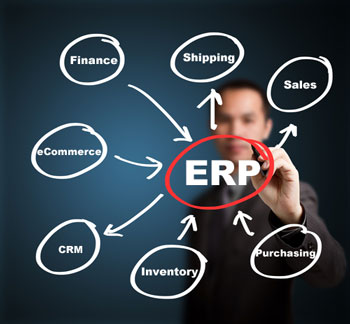A Hybrid Approach To ERP Implementation

Whether to keep enterprise resource planning (ERP) software in house to manage transaction processing of buyer/supplier purchases and other business activities such as accounting and inventory, or to pursue a cloud-based system through a third party, businesses have a variety of options. A hybrid approach is one of them, as for some firms it could save money and also keep certain operations under their own tight controls.
As IDC’s recent Worldwide Semi-annual Public Cloud Services Tracker showed, ERP and customer relationship management services make up the majority of global cloud spending. Specifically, the worldwide market for cloud services hit $45.7 billion during 2013. Of that total, $10.78 billion (24 percent) was spent on ERP systems. Not a small sum, but illustrative of how companies are looking to make their operations as efficient as possible.
As a recent Midsize Insider article pointed out, ERP has fast become an essential element for businesses to succeed, with cloud-based services emerging to take some of the responsibility away from staff within the company, not to mention to reduce cost. Shoe distributor RT Nash, for example, recently deployed such a new, more efficient cloud-based system to send a receive sales orders and invoices.
Some activities, however, are best suited to stay in house. Transaction processing, however, is a service best suited for the cloud, according to a recent blog post from Joshua Morrison, whose company Tradeshift operates a cloud-based transactional business. “Many U.S. companies have made significant capital investments in corporate [ERP] software to manage these transactions and look to leverage the ERP as much as possible to maximize the value from their associated sunk costs,” he said.
While acknowledging why they do so, given that the average ERP implementation across all industries costs nearly $10 million, and even more for manufacturers where the average costs reach almost $11.5 million, he suggested businesses could benefit from using a third party’s cloud-based software as a service (SasS) to support their transaction processing.
Indeed, as the Midsize Insider article points out, the purchase, setup and resources required could overwhelm the IT departments for many small and midsize businesses. However, while a cloud-based approach might help alleviate some of these issues, not all businesses want to trust third parties with financial data, despite the security advances third parties have made.
“The solution here, which many IT managers may miss, is a hybrid one,” the article notes. “The cloud can be used for resource-heavy aspects of the ERP solution, such as transaction management, while the rest of the solution can continue to run on the in-house infrastructure.”
As Morrison pointed out in his post, transaction management accounts for about 80 percent of ERP implementation time, with the remaining 20 percent focused on data management, reporting, and analytics. “Considering the average implementation costs upwards of $10 million, saving 80 percent of resource time and cost is quite significant,” he said.
Midsize Insider suggests midsize businesses are ideally suited to get the most out of the cloud because their size requires “a large, agile computing solution,” but their IT budgets generally prohibit strong in-house data center. “This kind of hybrid cloud solution, where resource-intensive aspects of a system are sent to the cloud for processing, should be in every midsize business IT manager’s tool belt,” the publication suggests.
